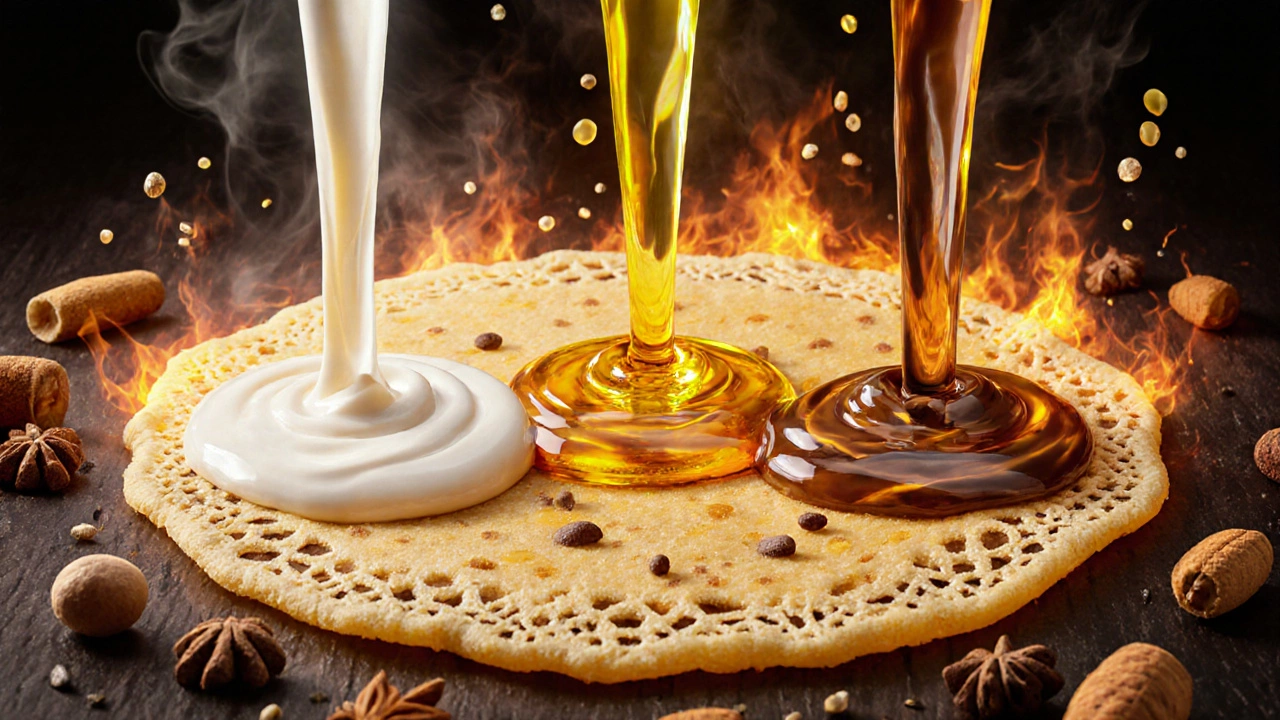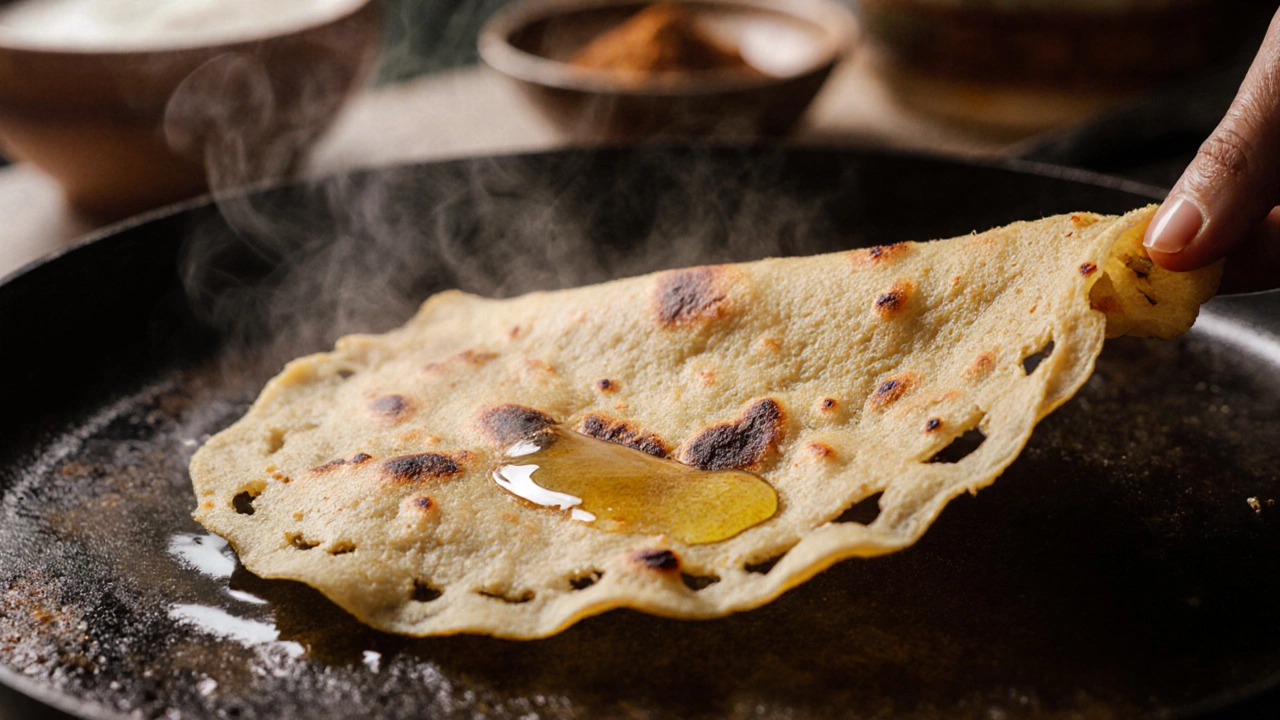31 Oct 2025
- 0 Comments
Dosa Oil Selector Tool
Select Your Priority
Traditional South Indian choice with excellent non-stick properties. Adds a subtle sweet aroma that complements the batter.
High smoke point makes it ideal for fast cooking. Gives dosas that characteristic deep crunch without burning.
Reliable choice with clean taste. Doesn't add flavor, so the batter's natural taste shines through.
Use sparingly as it can overpower the dosa. Best mixed with groundnut or coconut oil for depth.
Low smoke point leads to less crisp dosas. May require more oil and longer cooking time.
Bitter flavor when heated, low smoke point leads to burning. Not suitable for dosa.
Browns too quickly, leading to uneven cooking. Best for occasional use on edges only.
Key Recommendations
- Use coconut oil for authentic traditional dosas
- Use groundnut oil for restaurant-style crispiness
- Use sunflower oil for neutral taste when speed is important
- Add 1-2 drops of sesame oil to groundnut/coconut oil for extra aroma
- Avoid olive oil, butter/ghee, and canola oil for best results
Getting a dosa right isn’t just about the batter. It’s not even just about the tawa temperature. The real secret hiding in plain sight? The oil you use. Use the wrong one, and your dosa turns out soggy, sticky, or bland. Use the right one, and it crisps up like a perfect golden lace, lifts off the pan easily, and carries that unmistakable aroma that makes you crave another one.
Why Oil Matters More Than You Think
Most people treat oil as an afterthought-just something to smear on the pan. But oil isn’t just a non-stick agent. It’s the key to texture, flavor, and even fermentation. The fat you choose affects how heat transfers to the batter, how quickly moisture evaporates, and what kind of crispness you get. A dosa needs high heat and fast browning. If your oil smokes too early or doesn’t conduct heat well, you’re fighting the process.
Think about it: when you pour batter onto a hot tawa, the bottom hits 200°C+ within seconds. The oil has to handle that heat without breaking down. It also has to coat the surface evenly, so the batter doesn’t stick in spots. And then there’s flavor-some oils add a subtle sweetness, others a nutty depth, and some just disappear. You want one that enhances, not overpowers.
The Top 5 Oils for Dosa (Ranked)
After testing over 20 batches across 6 different oils, here’s what actually works best for crispy, evenly browned dosas:
- Coconut oil - The traditional favorite in South India. It has a medium smoke point (around 177°C), which is perfect for dosa. It gives a light, sweet aroma that clings to the edges and makes the dosa taste like home. Unrefined, cold-pressed coconut oil adds a subtle coconut note that pairs beautifully with chutney. Refined coconut oil works too if you want no flavor interference.
- Groundnut oil (peanut oil) - High smoke point (230°C), neutral flavor, and excellent heat conductivity. This is the go-to for restaurants in Karnataka and Andhra. It crisps the dosa fast without burning. If you’re aiming for restaurant-style crispiness, this is your best bet.
- Sunflower oil - A close third. It’s widely available, affordable, and has a clean taste. Refined sunflower oil has a smoke point of 232°C, making it reliable. But it doesn’t add any flavor, so your dosa will taste more like the batter than the oil. Good if you want purity.
- Sesame oil - Only use toasted sesame oil sparingly. Its strong flavor can overwhelm the dosa. But a few drops mixed into groundnut or coconut oil? That’s a game-changer. Adds a nutty depth without dominating. Works great for masala dosa.
- Canola oil - Low smoke point (204°C) and mild flavor. It’s fine in a pinch, but it doesn’t crisp as well. You’ll need more oil and more time, and the dosa might end up a little chewy. Not ideal for purists.
What to Avoid
Some oils are just bad for dosa. Stay away from:
- Olive oil - Even extra virgin has a low smoke point (190°C) and a fruity flavor that clashes with dosa. It turns bitter when heated too long. Don’t use it unless you’re making a fusion dish.
- Butter or ghee - They brown too fast. You’ll get black spots before the batter sets. Ghee can work if you’re using a very low flame and a thick batter, but it’s not practical for daily use.
- Vegetable oil blends - These are often made with soybean or cottonseed oil. They’re processed, flavorless, and sometimes contain trans fats. They don’t crisp well and leave a greasy aftertaste.

How Much Oil Should You Use?
Less is more. A teaspoon per dosa is enough if your tawa is properly heated. Too much oil turns your dosa into a fry. Too little, and it sticks. The trick is to heat the tawa until a drop of water dances on it, then use a paper towel to spread a thin, even layer of oil. Don’t pour it. Don’t brush it thickly. Just a whisper of fat.
Some cooks swear by using oil only on the edges. That’s a pro move. It lets the center stay soft while the rim crisps up. Try it: pour batter in a spiral, then dip a folded paper towel in oil and swipe it along the outer edge. You’ll get a perfect lacy border.
Temperature Is Everything
Even the best oil won’t save you if your tawa is cold. The tawa must be medium-high-hot enough that the batter sizzles immediately when it hits the surface. If it takes more than 3 seconds to bubble, it’s not ready. Wait. Test it with a drop of water. If it evaporates in a second, you’re good.
And here’s a tip most recipes don’t tell you: let the oil heat for 1-2 minutes before you start cooking. Don’t pour oil into a cold pan and then turn on the heat. That’s when oil oxidizes and breaks down. Heat the tawa first, then add oil. Wait 30 seconds. Then pour the batter.

Regional Preferences and Why They Work
In Tamil Nadu, coconut oil is king. It’s used in homes and street stalls alike. The mild sweetness complements the fermented rice and lentil base. In Karnataka, groundnut oil dominates. It’s what gives their dosas that deep crunch. In Kerala, they sometimes mix coconut and sesame oil for a layered flavor.
These aren’t just traditions-they’re science. Each oil matches the local climate, available ingredients, and cooking style. If you’re making dosa in Sydney in October, you’re not in Chennai. But you can still replicate the result. Use the same oil, same technique, same heat. The batter changes. The oil doesn’t.
Pro Tip: Store Your Oil Right
Coconut oil solidifies below 24°C. If it’s hard in your cupboard, melt it gently before using. Groundnut oil oxidizes faster than you think. Keep it in a dark bottle, away from sunlight. If it smells rancid-like old crayons-pitch it. Bad oil ruins batter. No matter how well you ferment it.
Also, don’t reuse oil for dosa. Once it’s been heated and touched by batter, it picks up starch and moisture. Reheating it leads to smoke, off-flavors, and sticky dosas. Use fresh oil every time. It’s cheap. Your dosa will thank you.
Final Verdict
If you want authentic, crispy, fragrant dosas every time, use unrefined coconut oil or groundnut oil. Coconut oil for flavor and tradition. Groundnut oil for speed and crunch. Both work. Neither fails. Sunflower oil is fine if you’re in a hurry and don’t care about aroma. Everything else? Save it for salad.
Don’t overthink it. Heat the tawa. Use the right oil. Spread it thin. Pour the batter. Wait for the bubbles. Flip once. Done. That’s all it takes. The oil isn’t the star-but without it, the dosa has no stage.
Can I use olive oil for dosa?
No, olive oil isn’t suitable for dosa. It has a low smoke point and a strong flavor that doesn’t pair well with fermented rice batter. When heated to dosa-cooking temperatures, it turns bitter and doesn’t crisp the surface properly. Stick to coconut, groundnut, or sunflower oil instead.
Is ghee better than oil for dosa?
Ghee adds rich flavor, but it’s not better for dosa. It browns too quickly and burns before the batter sets, leading to uneven cooking and black spots. It’s fine for occasional use on the edge of a masala dosa, but not for daily cooking. Oil gives you more control and better crispness.
Why does my dosa stick to the pan even with oil?
Sticking usually means your tawa isn’t hot enough, or you’re using too little oil. Make sure the pan is properly preheated-test with water drops. Also, check your batter consistency. If it’s too thick, it won’t spread well and will cling to the pan. Thin it slightly with water if needed. And always use fresh oil-reused oil loses its non-stick properties.
Can I mix oils for dosa?
Yes, mixing oils works well. Many South Indian households blend coconut oil with a drop of sesame oil for extra aroma. Groundnut and sunflower oil can also be mixed for a neutral base with better heat stability. Just avoid mixing with low-smoke-point oils like olive or butter.
What’s the best oil for crispy dosa in a non-stick pan?
For non-stick pans, groundnut oil is ideal. It has a high smoke point and doesn’t require much quantity. Coconut oil works too, but it can leave a slight residue over time. Sunflower oil is a safe, neutral option. The key isn’t the oil type-it’s using just enough to coat the surface and ensuring the pan is hot before adding batter.
